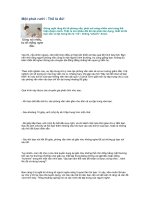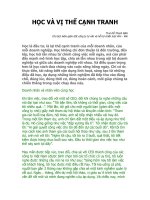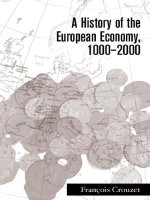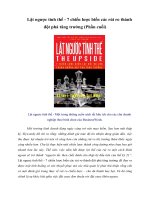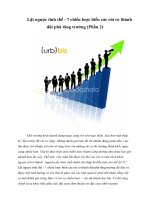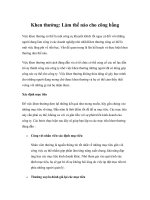Tài liệu Geopolitical Considerations behind the IT Consumerism Michele La Neve pot
Bạn đang xem bản rút gọn của tài liệu. Xem và tải ngay bản đầy đủ của tài liệu tại đây (773.93 KB, 47 trang )
Geopolitical Considerations behind the IT Consumerism
Michele La Neve
.
Smashwords Edition
Copyright 2012 Michele La Neve
License Notes: This ebook is licensed for your personal enjoyment only. This ebook may
not be re-sold or given away to other people. If you would like to share this ebook with
another person, please purchase an additional copy for each person you share it with. If
you’re reading this book and did not purchase it, or it was not purchased for your use
only, then you should return to Smashwords.com and purchase your own copy. Thank
you for respecting the hard work of this author.
Ebook formatting by www.ebooklaunch.com
TABLE OF CONTENTS
1. GENERAL CONSIDERATIONS ABOUT INTERNATIONAL TRADE, WHAT
IS COLTAN?
1.1 THE IT MARKET WORLDWIDE
2. THE EXTRACTION OF COLTAN
3. THE CANONICAL PROSPECTIVE OF THE WAR IN THE DRC
4. POLITICAL AND HUMANITARIAN ISSUES
5. STOP CONSUMING IS THE RIGHT WAY TO PURSUE?
6. THE POLITICAL SCENARIO IN THE REGION
7. LINKS BETWEEN THE EXPLOITATION OF NATURAL RESOURCES AND
THE CONFLICT IN THE DRC
7.1 OTHER INITIATIVES TO STOP THE PHENOMENON
8. IS “FAIR TRADE “AN OXYMORON?
9. CONCLUSIONS
10. APPENDIX
11. REFERENCES
Acknowledgments
I would like to take the opportunity to thank those who helped me in making this text
proof readable for their time and their patience; Jackie Gallegos, Folakemi Alli Balogun
and David De Fazio, for their friendly help and support.
I am very happy for the “social experience”, as Aristotle would say, I have been able to
experiment during my studies for all those students I met, the real radix sapientiae of any
University.
Abstract
This work starts from an academic project for the “Policy and Sustainability” class at the
International University of Monaco, although the topic is the same, the aim is completely
different; here I tried to point out a completely different way to deal with business, which
should be headed towards human dignity firstly and, as a consequence, towards profit.
During these difficult years, in fact, we have been experimenting the importance of
having moral values. The financial crisis of 2008 is probably the best example of what
the utilitarian, short-term approach is; earning money for the sake of doing it does not pay
back if there is no development for everybody. This is the lesson we should learn.
This is what we should aim for, exactly like Adam Smith and Immanuel Kant wrote
centuries ago and Amartya Sen and E.F. Schumacher only a few decades ago.
To support my conclusions, especially the need to switch towards a moral attitude,
eventually, I used the “Theory of Moral Sentiments” and the “Critique to Practical
Reason” written by the aforementioned philosophers, and, in general, material provided
by moral philosophy.
Hopefully, I will be able to going further with my research through further studies.
1. GENERAL CONSIDERATIONS ABOUT INTERNATIONAL
TRADE, WHAT IS COLTAN?
Homo homini lupus, by Thomas Hobbes, is probably the sentence that best fits and
describes what the international trade actually is. Literally, it means “the Man is a wolf to
Man”, where “Man” has to be understood as human gender and the sentence above
describes the basic principles of the “natural state”. This status claims that the human
activity is mainly driven by the personal best interest, by the “particulare” as Guicciardini
would say[1].
According to this theory, in fact, the human behaviour is not that different from the
animal world; recognizing as priorities the survival and the oppression of other men.
During history, several are the examples of this principle, such as the “zero-sum” game as
epitomized by the realist theory in International Relations theory.
During the Roman empire the motto “mors tua vita mea” “your death means my life” was
coined to underline how bad human nature could be and it could not be different for a
culture that used to enjoy watching gladiators at the Coliseum.
Although I strongly believe these are still the core values for most of us, related to the
animal world more than the human one, we should keep in mind that, since then, the
human gender has hopefully evolve. Even though the aforementioned examples are just
history for the civilized world, we should not underestimate what has been happening in
the poorest part of the planet, in Africa, for instance.
In order to understand what coltan is, we should start from its usages and origins; coltan,
tantalum its chemical name, has been recently refined by Werner Von Bolton in 1903 for
the first time (Chemicool), It is a shiny, gray, dense metal, highly ductile and it can be
drawn into technical wires. (Chemicool).
The reasons why it is so well known and used in the IT field are mainly due to its
physical characteristics; coltan is very resistant to corrosion and high temperatures and it
is an excellent conductor of heat and electricity. (Chemicool)
We all know that industrial technology has had a huge development during the last
decade, nevertheless, scientists are still fighting against heat in order to preserve the
quality and the integrity of their technological products.
In fact, all electronic devices share a common issue, which needs to be fixed in order to
preserve their own performance and safety, that is, heat production.
For instance, personal computers have become faster and more and more sophisticated
thanks to a significant increase in microprocessors’ capacity; whereas the other side of
the coin is the massive production of heat, near 100° Celsius in a few cases. (Apple Inc.,
2012)
Consequently, it is very difficult to preserve the integrity of the system, especially when
markets require smaller and smaller mobile phones and laptops.
It is not difficult, especially for the ones who have been using personal computers for
several years, to remember the difference, both in dimensions and in performance,
between the devices used until a few years ago and the new ones. If we have had this
extraordinary evolution, the credit should go, besides to engineers and researchers, to the
large use of coltan in all those devices.
The core of every computer, as written before, is the CPU; the microprocessor, when its
speed in mathematical calculations increases, this is what happens; it needs more energy
and consequently, it gets extremely hot. That is how it looks like one of the newest on the
market.
Nowadays, coltan is used in almost all technical fields; due to the large use of electronic
devices in our daily life, such as car and aerospace industry, telecommunications and
medical sector, among the others.
The aforementioned list is just an example of all coltan’s uses. In general, we can affirm
that it is used whenever there is an electronic microchip.
Moreover, along with all the other relevant characteristics, it does not cause any immune
response by the human body; that is why coltan is used for surgical and dental implants
as well. (Chemicool)
The other important aspect is that coltan allows to save energy, allowing to build smaller
batteries and, consequently, smaller devices. (Università di Bologna, 2011). In addition,
we have to underline that Coltan, once used, is not recyclable and, at this stage, there are
no suitable alternatives.
Another way to reach similar results can be represented by ceramics but studies to make
it work on small devices are still ongoing. However, we are not going to use ceramics on
our IT devices for other 5 years, at least. (Università di Bologna, 2011)
Moreover, once a coltan-field is discovered, such as in the Katanga province, in the
Democratic Republic of Congo, it is relatively easy to extract.
As already pointed out, “Tantalum (coltan) is almost completely immune to chemical
attack at temperatures below 150°C, and is attacked only by hydrofluoric acid, acidic
solutions containing the fluoride ion, and free sulphur trioxide.” (Webelements)[2].
The goal of this research is to demonstrate the connection between the consumption and
the exploitation of the DRC natural resources and to propose some ideas such as technical
research for suitable alternatives to coltan. Even more importantly, this research is aimed
to propose a shift from an utilitarian, short term way to do business towards a more social
and, by the human point of view, more acceptable one.
It obviously does not mean that corporations should not aim to increase their profits,
which allow them to increase their workforce, amongst other things. They should
doubtless preserve their shareholders’ interests, but, they should do it bearing in mind an
holistic approach. This “new way” (new for the business world, since, as we are going to
see very soon, philosophers claimed it centuries ago), should, on one hand, not just earn
as much profits as possible in the shortest timeframe, but, on the other hand, it should be
headed towards positive externalities, latu sensu, the ones that create a virtuous circle.
The same at political level, we are going to see, in fact, that the civil war that is affecting
the Democratic Republic of Congo is driven by the economic interests of firms located in
some western countries, that are using local political powers to reach their goals.
Also in the political sector, politicians should not act in order to reach their personal
objectives; either elections or coups d’état. By doing so, they just achieve their own
particulare, in most of the cases, ignoring the general well being. (Guicciardini, 2008).
This attitude, on the other hand, does not create any development or any new possibility
of growth whatsoever.
On the contrary, this unwise, and, in some cases, criminal, behaviour must be stopped
since it is strictly linked to the elite’s interests rather than general ones and usually it
comes along with other unpleasant phenomena such as corruption, nepotism etcetera.
What is more, one should admit that, ideally speaking, elected, authorities are the most
important and best example of democracy, since they are supposed, as Plato in his
“Republic” pointed out, “to make prisoners free” (Plato, La Repubblica, 2007)
1.1 THE IT MARKET WORLDWIDE
Before elaborating the essential point of this thesis, I truly believe an analysis of the IT
market is crucial, since the companies operating in this field are the most important
coltan’s consumers. The increase of sales of electronic devices has been significant in the
last few years, therefore, IT companies are more and more concerned about finding
appropriate resources of Coltan. Being without it would mean that the production has to
be stopped; a too high price for the companies, that they are absolutely not willing to pay.
In order to better understand the importance of the high tech market, it is important to
know some figures concerning the sales of IT devices. Apple, for instance, has sold more
then 170 million “Iphone” devices since 2007 (Il Giornale, 2012).
In addition we should mention other competitors such as Research in Motion; the
BlackBerry producer, Nokia, Samsung, Motorola, HTC, just to mention the best known
ones world wide.[3]
We are talking about billions of USD, if we only think that 234 million US residents
above 13 years old have a smartphone, we can easily understand how important the
above mentioned figures and their impact on the economy are. (ComScore, 2011).[4]
Furthermore, we need to consider computers, either desktops or laptops, just to study
home consumption and, if we take into account how important it has become having the
last technological gadget to show an appropriate status symbol. The rituality of changing
devices from time to time has been considered by many people compulsory.
As written above, Coltan cannot be recycled and it is a non renewable resource like all
minerals, so this lead towards an incredible increase in its prices, from 65 USD in 2000 to
600 USD per kg, which is its current price (Reschia, 2012)[5]
To corroborate this statement we should think about what happened a few years ago, in
2001, when, at a certain point, Sony had to stop the production of the “PlayStation 2”
because coltan’s extraction had become impossible because of the war in the Democratic
Republic of Congo. (Rai News 24)[6]
Besides, if we think about how many cell phones, videogames and computers are sold
every year, we can figure out how important it is having appropriate resources of this
mineral.
Moreover, we need to point out the growing position of the emerging countries such as
India (the second world market for mobile phones with more than 260 million users)
(mobiThinking, 2012) and China, whose huge population make this market extremely
relevant for IT producers.
Always concerning mobile phones, according to the aforementioned figures, we can see
how China has the largest quota of subscribers followed by India and the USA
(mobiThinking, 2012)
The table above, on the other hand, shows the number of subscribers in relation to the
three main Chinese operators.
Moreover, there is another aspect that should be acknowledged; the growing importance
of Chinese producers. Huawei, ZTE, Arcos, were just unknown brands until one or two
years ago.
However, thanks to the Chinese labour law, which does not provide many rights to
employees[7], these producers can sustain incredible production paces, in order to satisfy
the demand, creating, consequently, revenues.
Very recently, the market share of these new producers has become a geopolitical issue
due to the fact that smartphone’s usage has become wider.
Most people, nowadays, use their smartphone also to surf the Internet and to exchange
emails or even to buy goods or services through their credit card; consequently, this
means that a lot of sensitive information is stored on Chinese devices.
Whether this should be considered or not a security issue, is something police authorities
are supposed to deal with and now it is probably too early to have an opinion based upon
relevant facts rather then economic interests.
At this moment, we can just say that American security agencies strongly recommend to
their officers and entrepreneurs not to use any devices made by Chinese producers.
(Garroni, 2012)
In the meantime, the following tables show some figures concerning the growing
importance of these new producers:
Source: (Huawei, 2012)
Using the table above just as an example, we can immediately see how much revenues
have grown since 2007; from 92,1 to 204 USD Million.
Arcos, another Chinese brand, does not have different figures:
Source: (Archos, 2012)
Although, this time, figures are expressed in Euro, the results achieved in just one year
are simply extraordinary.
This should demonstrate that China, unlike India, besides being the most important
market, has also become an important producer of IT products and this fact is extremely
interesting according to the growing international power China is gaining, also from the
political point of view.
To corroborate what just stated, the following graph shows the China’s imports of coltan:
.
Figure 1.1. China’s imports of Coltan from African countries
Retrieved from (Raimund Bleischwitz, 2012)
As suggested above, the situation is not going to improve since, apparently, India is going
to surpass China reaching, alone, more than 260 million units of mobile phones by 2014
(BBC News, 2012). Therefore, having appropriate and adequate sources of imports to
satisfy coltan’s demand will become more and more important for producers to sustain
the demand.
Concerning China, moreover, we need to point out a shift in the coltan trade; during the
last decade, western countries were the most important buyers of this mineral from the
DRC. Afterwards, Asian countries, China in primis, started increasing their imports.
(Raimund Bleischwitz, 2012)
Retrieved from (Raimund Bleischwitz, 2012)
2. THE EXTRACTION OF COLTAN
Coltan is a mineral mainly found in the DRC mines, although it is also available in other
countries such as Australia, Canada, Brazil and Mozambique. Nevertheless the
Democratic Republic of Congo has itself more than 80% of world wide reserves of this
mineral. Furthermore, it can be extracted more easily from the DRC, since, apparently, it
is the only place where it is not stored in the rocks but in the ground[8]. (Università di
Bologna, 2011)
Moreover, China, which seems to have this mineral on its territory, has stopped partially
its exports; this decision is probably due to the fact the Country is not only deeply
involved in the IT components production, (in fact, most of the worldwide production
takes place in China), but also it is heavily investing in the military field[9]. (Rai News
24)
Figure 3: the world production of coltan
Retrieved from (Raimund Bleischwitz, 2012)
Consequently, it is definitely easier and profitable to extract Coltan in the DRC than in
any other place in the world, although, as we are going to realise what price the local
population is paying, especially in terms of health.
It now becomes clearer why multinational companies are keen to pay coltan workforce
involved in this business much more than the normal average in DRC: 200 USD against
10 per month (which is the common wage). (Calianno, 2011).
Since being paid 20 times more is, therefore, an incredible opportunity for many of those
interested in improving their living conditions, western companies do not have to worry
about finding workforce. Unfortunately for those involved, the situation is much more
complicated and unsafe for them.
Coltan is, in fact, radioactive, due to a small percentage of uranium which is naturally
stored in it and, Congolese people are used to extract it without any protection.
Consequently, the possibility to get cancer or some other health issues related to the
exposure of this mineral is extremely high, especially because people work in the coltan-
fields on a daily basis[10]. (Calianno, 2011)[11]
We need also to underline that the local workforce, sometimes, is obliged to work in poor
conditions because of the situation within the country. For instance, rebels supported by
foreign countries like Rwanda, Uganda and Burundi continuously threaten them. These
rebels are supported to fight the regular Congolese government and its regular army to
reach the control of Congo’s natural resources[12].
According to the Panel of U.N. experts sent to the Country, the illegal exploitation of
natural resources is, in fact, facilitated by the administrative structures established within
the Democratic Republic of Congo by Uganda and Rwanda, mainly.
Those countries appointed, by means of their leaders, directly or indirectly, regional
governors or local authorities or, more commonly, appointed or confirmed Congolese
people in these positions. In 1999, Uganda appointed as Governor of one of the DRC
richest provinces in terms of natural resources, Adele Lotsove, a Congolese who had
already been employed by the Mobutu and Kabila administrations[13].
The UN Panel clearly indicates that she was the fulcrum in the collection and transfer of
funds from her assigned administrative region to the Ugandan authorities in 1999[14].
On the Rwandan side, Rwandan authorities have helped secure the appointment of
Gertrude Kitembo as Governor of Maniema[15].
3. THE CANONICAL PROSPECTIVE OF THE WAR IN THE DRC
According to the official versions of the war, the conflict in the DRC is known as “the
African world war” (Percorsi di Pace, 2012). This phrase is particularly interesting since,
as mentioned before, it clearly shows the weight of foreign countries within a conflict
that is formally known as a civil conflict.
Political problems rose in 1994, further to the Rwandan genocide made by the Hutu
faction, which, eventually, was defeated by the Tutsi one.
This last faction gained the power in Rwanda and, pursuing the aim to keep fighting
against the Hutus, sent its troops in the Democratic Republic of Congo. (Raimund
Bleischwitz, 2012)
As we are mostly aware, although Africa is the poorest part of the world, it is extremely
rich in terms of natural resources, as shown in the following image:
Figure 4. Africa’s natural resources
Retrieved from (The Economist , 2012)
As a consequence, the control of its resources is the key point to understand what stands
behind the “coltan affair” and, as a whole, the political situation in Africa.
To corroborate this hypothesis we can just take a look to all the factions actually involved
in the conflict:
The DRC army, Mai-Mai militia, Namibia, Zimbabwe, Angola, Chad, Sudan, Uganda,
Rwanda, Burundi, Tutsi militia, Rassemblement Congolaise Démocratie
As we can see, the number of armies and countries involved is quite impressive,
definitely too much for a simple “tribal conflict”.
Somebody must be interested in keeping this area a conflictual one. We are going to see
in this study how western companies, or, rather, western countries are the ones behind
this situation; the same ones that pretend to stop the conflict through a inadequate U.N.
mission, the MONUSCO - United Nations Organization Stabilization Mission in the
Democratic Republic of Congo.
It must be underlined that the appointment, in 1996, of an Hutu leader as refugees’
representative gave to the Hutus the means to keep fighting against Rwanda.
Starting from that moment, the Rwandan’s involvement became inevitable and headed to
war.
4. POLITICAL AND HUMANITARIAN ISSUES
Like most African countries, the Democratic Republic of Congo still does not have a
defined and safe political situation.
Its natural resources, in particular, attract interests by any kind of groups, either from
inside or outside the Country.
The aforementioned natural resources are; diamonds, gold and coltan. (Rai News 24)
As correctly pointed out by the U.N. Panel “Exploitation of the natural resources of the
Democratic Republic of the Congo by foreign armies has become systematic and
systemic”. (The United Nations, 2001)
Besides, there is a relevant security issue concerning those groups that actually occupy
the caves; this problem should not be underestimated because of the “ramifications and
connections worldwide” (The United Nations, 2001).
Besides, there are some relevant interests regarding the commercialization of those
resources since most of them are sold abroad using unofficial, and, perhaps, illegal
methods.
Since the colonization of African countries, the European ones have always had a role in
their internal affairs and this is exactly the case of Congo nowadays; diamonds, gold,
computer, oil are obviously sold to foreign countries where the demand for this kind of
products is higher and better paid.
Consequently, many people and foreign countries are interested in controlling this huge
asset destabilizing the democratic political environment of Congo.
It is very well known, in fact, that civil wars which afflicted Congo, were mainly driven
by economic interests (like most wars) between Congolese Government and irregular
troops coming from Rwanda and Uganda (Rai News 24). This situation lead towards a
civil war, whose official reason has been claimed to be a “tribal conflict”.
Concerning this point, the Panel is very clear identifying “western” responsibilities in
keeping the conflict going: “A number of companies have been involved and have fuelled
the war directly, trading arms for natural resources. Others have facilitated access to
financial resources, which are used to purchase weapons. Companies trading minerals,
which the Panel considered to be the engine of the conflict in the Democratic Republic of
the Congo have prepared the field for illegal mining activities in the country”[16]. (The
United Nations, 2001)
The panel, moreover, gives its interpretation of the conflict, which is definitely an
unusual one, due to the low level of fighting against already mentioned belligerents.
“The conflict in the Democratic Republic of the Congo, because of its lucrative nature,
has created a “win-win” situation for all belligerents. Adversaries and enemies are at
times partners in busines, prisoners of Hutu origin are mine workers of RPA, enemies get
weapons from the same dealers and use the same intermediaries. The only loser in this
huge business venture is the Congolese people”. (The United Nations, 2001)
As matter of fact, I strongly believe this conflictual situation has been put in place to
protect foreign interests in the region by means of DRC’s natural resources exploitation.
Regarding these political aspects, we need to mention the role of the United Nations,
which in 2001, had a role declaring clearly that “an exploitation of Congo’s natural
resources was taking place” (United Nations Security Council, 2001) and “the revenues
were used by Uganda’s, Burundi and Rwandese armies to finance the war”.
Besides, “it has been estimated that Rwandese army made more than 250 USD million
selling coltan” (The United Nations, 2001)
The aforesaid sentence, expresses definitely a paradox situation; Rwanda does have very
limited resources of coltan, consequently, the international community did not wonder
how come they were able to sell it in a much higher amount.
Concerning the way this business is managed, most of coltan illegal traffic has been in a
woman’s hands, Aziza Gulamali Kulsum, who owns a cigarettes plant near the Rwandese
border. (United Nations Security Council, 2001)
According to the Panel, she would have sent abroad minerals such as coltan, gold and
diamonds using corporations built ad hoc such as “SOMIGL”; “Société minière des
Grands Lacs” which, in monopoly regime, exports coltan via Rwanda paying just 10% of
its revenues to the Congolese Government as taxes.
She has been accused of having paid rebels that fight Congolese regular army who are
part of Rassemblement congolais pour la démocratie (RCD). (The United Nations, 2001)
However, since we are talking about illegal traffics, precise estimations are, obviously,
impossible to assume, due to the lack of precise figures[17].
Under the light of this scenario, it needs to be acknowledged that the United Nations have
not imposed their voice within the region so far, fixing the issue for good; the most
important achievement reached has been a resolution, as a result of the MONUSCO
report. (United Nations Security Council, 2001)
In particular, according to the aforementioned statement, the exploitation of Congolese
natural resources happens for the following reasons; (The United Nations, 2001)
“The behaviour of some countries like Angola to finance the civil war[…] The
exploitation of Congolese resources to finance the war like Rwanda,
The intervention of countries like Zimbabwe or Rwanda to keep the war in Congo going
to increase their incomes,
Private interests of politicians like Victor Mpoyo, Gaetan Kakudji, Mwenze Konkolo
within the RDC,
The behavior of one of the part in conflict which usually distributes profits or other utility
to soldiers and/or rebels of the RCD”[18].
When reading the above mentioned report it becomes perfectly clear how those countries
are actually involved in the “coltan affair” and how they send the mineral abroad.
What is more, the point 74 of the report, in fact, explains perfectly that, “ On the
Ugandan side, three main private companies are involved:
* “Air Alexander, whose owner is Jovia Akandwanaho, the wife of Salim Saleh and
sister-in-law of President Museveni. According to some sources, the company continues
to operate in the territory held by Ugandan troops”.
* “Air Navette has dealings with General Salim Saleh and Jean-Pierre Bemba”.
* “Uganda Air Cargo, which mainly deals with the Ugandan Ministry of Defence.”[19]
(The United Nations, 2001)
The point 75, likewise, explains how Rwanda did the same:
“New Gomair. According to some sources, the wife of the current Minister of Finances of
Rwanda is a shareholder, Air Navette flies to Goma, Bukavu, Kisangani and Kigali.
According reliable sources, one of the major shareholders, Modeste Makabuza, also
owner of Jambo Safari, is a known figure in the entourage of President Kagame.
Air Boyoma is a shuttle between Goma and Lodja; according to some sources Mr.
Ondekane, former first Vice- President of RCD-Goma, is a shareholder”[20]. (The United
Nations, 2001)
On the other side, the report clearly shows the financial network behind the coltan trade
and, similarly, the ways used by the above mentioned countries; while the point 76 keeps
explaining which are the banks actually involved:
“Union des banques congolaises. Although the headquarters remains in Kinshasa, it has
ongoing operations in areas controlled by Rwanda,
Banque commerciale du Congo. The headquarters is in Kinshasa and it has branches in
the eastern Democratic Republic of the Congo. The Director was transferred to Kigali in
order to oversee operations in the eastern Democratic Republic of the Congo. This bank
is linked to the Belgolaise, a Belgian bank consortium,
Banque commerciale du Rwanda. The headquarters is in Kigali, but it has operations in
Kisangani, Bukavu and Goma. The Government of Rwanda is said to be one of the
shareholders,
Banque à la confiance d’or (BANCOR). One of the newest banks in Kigali which started
its activities in 1995. It was family owned until 1999 but early in 2000 a businessman,
Tibere Rujigiro, purchased the bank at a very low price according to various sources”[21]
(The United Nations, 2001)
As we can see, there are extremely important interests, which concern Uganda’s and
Rwandese political leadership in the exploitation of the DRC’s natural resources, along
with western firms.
Retrieved from (The United Nations, 2001)
“The Ugandan authorities, in their response to the Panel’s questionnaire, stated that there
was no record of transit of mineral products.” (The United Nations, 2001)
The table shows clearly that Uganda has, exactly like Rwanda, very limited resources of
coltan, however, concerning years 1998 and 1999, it is strange how Uganda has been able
to export respectively 18,5 and 69,5 tons of that mineral.
Likewise for Rwanda, whose authorities declared there is “no production of diamond,
cobalt, zinc, manganese, and uranium”[22].
Retrieved from (The United Nations, 2001)
According to the U.N. Panel (art.104) “Production figures display some irregular patterns
for gold and coltan starting from 1997 […] It is revealing that the increase in production
of these two minerals appeared to happen while rebels, backed by Rwandan troops, was
taking over power in Kinshasa.” (The United Nations, 2001)
This “strange” behaviour in the natural resources international trade also affects, although
less significantly, Burundi:
“Burundi does not produce gold, diamonds, columbo- tantalite, copper, cobalt, or basic
metals”. Burundi, however, has been exporting minerals it does not produce. As in the
case of Uganda and Rwanda, Burundi’s export of diamonds dates from 1998, coinciding
with the occupation of the eastern Democratic Republic of the Congo.”[23] (The United
Nations, 2001).
Once again, the vicious circle between the conflict and exploitation must be underlined
and I strongly believe that personal or limited interests of African leadership have been
certainly playing a role but not as significant as the one played by the global firms, that
are the real buyers of the DRC natural resources.
This feeling is corroborated by the fact that the Panel has been threatened during its
activity in the DRC. (Rai News 24)
As we saw in the introduction, the IT market is worth billions and we cannot deny the
huge interests of those companies: most of those US based, in keeping Kinshasa’s
government unable to control the situation within its borders
As we can notice reading the table, most companies are from the “developed world”, this
should demonstrate that we are facing phenomenon definitely bigger than a “tribal
conflict”.
